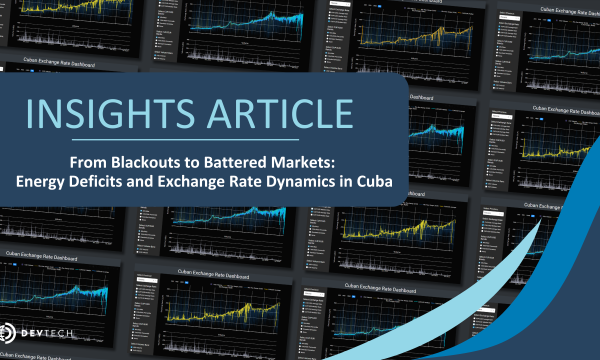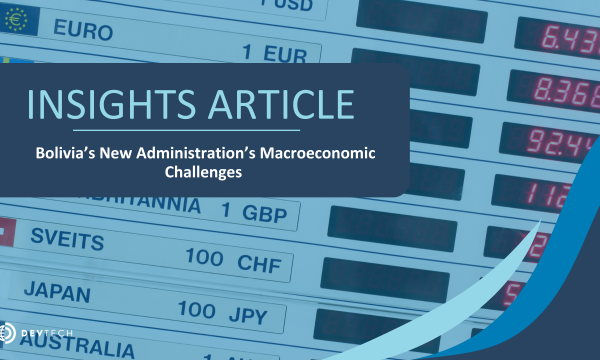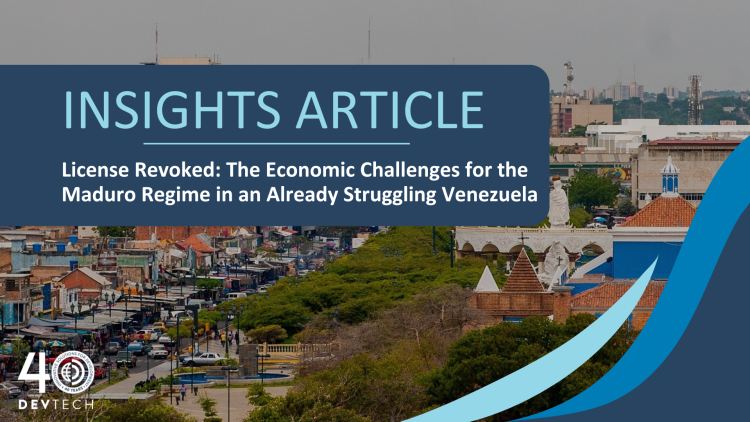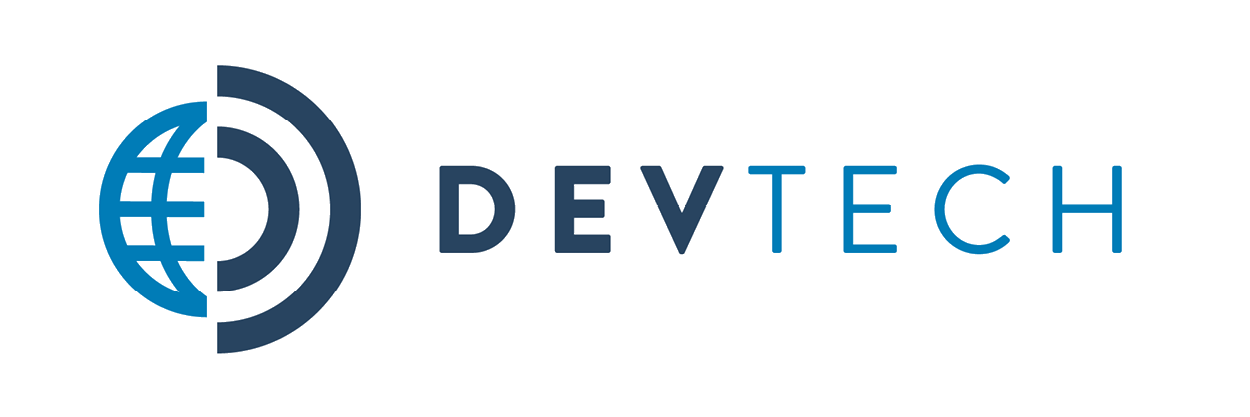On January 10, 2025, Nicolás Maduro began his third term as Venezuela’s president. Maduro took office even after losing the election in July of the previous year and despite the opposition’s proof of their historical and significant victory. Just six weeks later, on February 26, in response to failed negotiations carried out for the release of American political prisoners in exchange for the release of deported Venezuelans, the new U.S. administration under President Donald Trump gave Chevron 30 days to liquidate its operations in Venezuelan territory, thus revoking the 41-A license which had allowed the oil giant to operate in the country
By the end of March 2025, the United States had imposed a 25% tariff on countries purchasing Venezuelan oil and natural gas. This double hit—the license cancellation and the new tariffs—led several companies and countries (like Repsol from Spain, Eni from Italy, Global Oil Terminals, and China) to reduce their oil trade with Venezuela.
These moves are expected to cost Venezuela at least $3.1 billion in lost oil exports. This could have a serious impact on the economy. From 2021 to 2024, Venezuela had shown signs of recovery, with average yearly economic growth of 7.5%. According to OPEC, oil production reached 910,000 barrels per day by the end of 2024—up from just 336,000 barrels per day in June 2020, which was a historic low.
2019: A Government without legitimacy
In 2019, many countries—including the U.S.—refused to recognize Maduro’s re-election, calling it fraudulent. They responded with sanctions, freezing $7 billion in assets from the national oil company (PDVSA) and banning U.S. companies from doing business with it.
In 2023, the Biden administration temporarily eased some of these sanctions after Maduro’s government made political agreements with the opposition in preparation for the 2024 elections.
Even though the U.S. relaxed some rules in late 2023, oil exports to the U.S. didn’t return to normal. From December 2023 to December 2024, Venezuela exported an average of just 102,000 barrels per day—a 93.9% drop compared to previous levels during earlier sanctions.
To get around sanctions and bring in money, PDVSA secretly sold oil to countries like China. These sales totaled about $4.04 billion by the end of 2023. Still, that was a 72.8% drop compared to 2019.
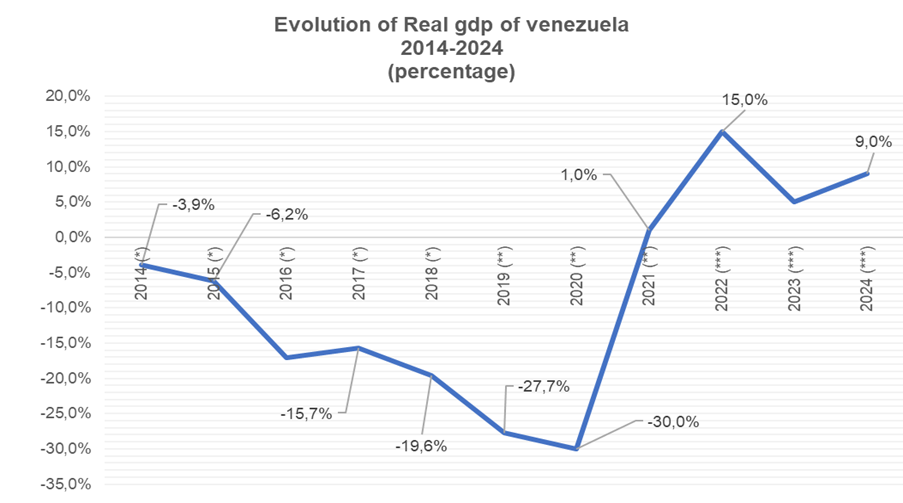
From economic collapse to a modest recovery
Venezuela’s economy crashed between 2014 and 2020 due to falling oil prices, government controls, and the COVID-19 pandemic. In 2020, economic activity dropped by 30%, pushing the country back to 1968 levels.
In 2021, the economy started to recover. By 2022, growth had reached 15%, helped by oil, manufacturing, trade, hospitality, and IT services. But even with this progress, the economy in 2024 was still smaller than it was in 2019.
Inflation, while still high, slowed. By February 2024, inflation was at 89.6%. This drop was helped by a stable exchange rate and the Central Bank’s tough monetary policies. Venezuela was no longer officially in hyperinflation, but inflation remained above 45%, and risks were still high due to low international reserves ($10.3 billion at the end of 2024).
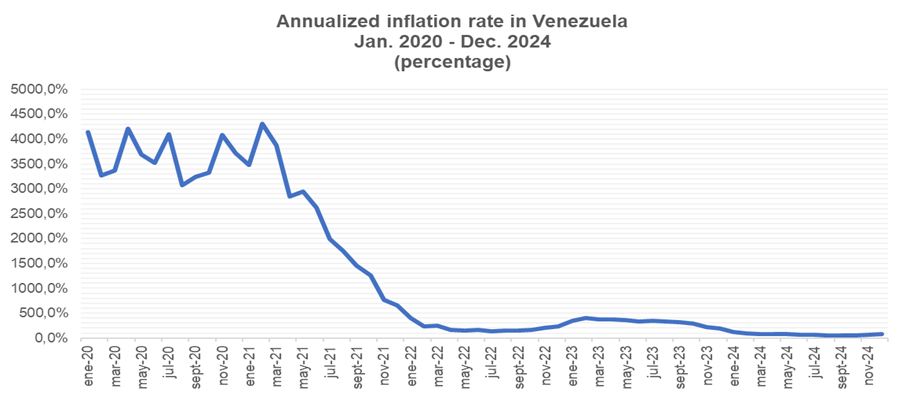
Tax collection improved too—up 12% in 2024. Income tax jumped 175%, and customs duties rose 36%. However, heavy taxes on businesses discouraged investment and led many to avoid taxes or operate informally.
Chevron’s role and the impact of License 41-A
Venezuela’s oil production had been falling for years, reaching a record low of 336,000 barrels per day in June 2020. After new political agreements in 2023, the U.S. Treasury issued License 41, letting Chevron resume limited oil work in Venezuela through joint ventures with PDVSA.
Thanks to this license, oil production between December 2023 and December 2024 held steady between 800,000 and 910,000 barrels per day. This was 22% higher than when sanctions began in 2019, but still far below the 3.36 million barrels per day Venezuela produced in 1998.
Chevron provided key resources for production—especially diluent, a lighter oil needed to mix with Venezuela’s heavy crude so it could be processed and exported. In 2019, Venezuela had bypassed sanctions by secretly getting diluent from Iran through condensate (very light form of oil) swaps.
New U.S. actions in 2025: More pressure on Maduro
In 2024, Chevron’s work helped Venezuela export about 200,000 barrels of oil daily, supplying money to Maduro’s government. But in March 2025, the Trump administration canceled License 41-A. Chevron had to shut down all operations by April 3. This also meant Chevron could no longer pay taxes or royalties to Venezuela or share profits with PDVSA.
Soon after, the U.S. imposed a 25% tariff on countries buying Venezuelan oil or gas. This affected China the most—it bought 68% of Venezuelan oil exports in 2023.
Chevron played a significant role in Venezuela’s oil industry. It produced 212,000 barrels per day—25% of national production—and provided 30% of Venezuela’s foreign currency.
With Chevron leaving, PDVSA will likely take over its projects. But this will lead to lower investment, and oil production could drop by at least 100,000 barrels per day. Venezuela will have to sell oil on the black market at a discount—about 48% less than Brent oil prices. This could cut $4 billion from Venezuela’s foreign income in the next year.
Venezuela’s emergency response
Vice President Delcy Rodríguez announced a new plan called the Absolute Productive Independence Plan, promising to keep the economy and oil sector stable. However, no details were given about how the plan would work.
President Maduro also declared a 60-day economic emergency (renewable) and passed a decree with the following actions:
- All tax revenue must go to the national treasury.
- Tax exemptions are suspended.
- The government can take steps to attract investment and promote exports.
- The government can spend more than the official budget.
- The government can borrow more money, change debt terms, or exceed legal debt limits.
But these measures don’t match Venezuela’s economic reality. Inflation jumped by 13.6% between February and March 2025, reaching 136% annually. Between 2016 and 2020, Maduro had already issued similar emergency decrees—27 times—which coincided with hyperinflation until 2021.
Now, experts expect Venezuela’s income-generating capacity to fall by 30%. Oil production may drop 25%. Economic growth in 2025 will likely be worse than in 2024. A survey by the Venezuelan Finance Observatory predicts the economy will shrink by 3.5% and inflation could go above 150%. The exchange rate is collapsing (down 188% year-over-year), and oil prices are 17% lower than in 2024.
Final thoughts
The cancellation of Chevron’s 41-A license and new U.S. tariffs mark a major setback for Venezuela. Although there had been some recovery, the economy is still very fragile and heavily dependent on oil. Losing Chevron’s production and investment will worsen the crisis.
The government’s emergency plans are vague and disconnected from Venezuela’s real economic problems. Without meaningful reforms, Venezuela will likely face deeper inflation, lower oil revenue, and further economic decline in 2025.


